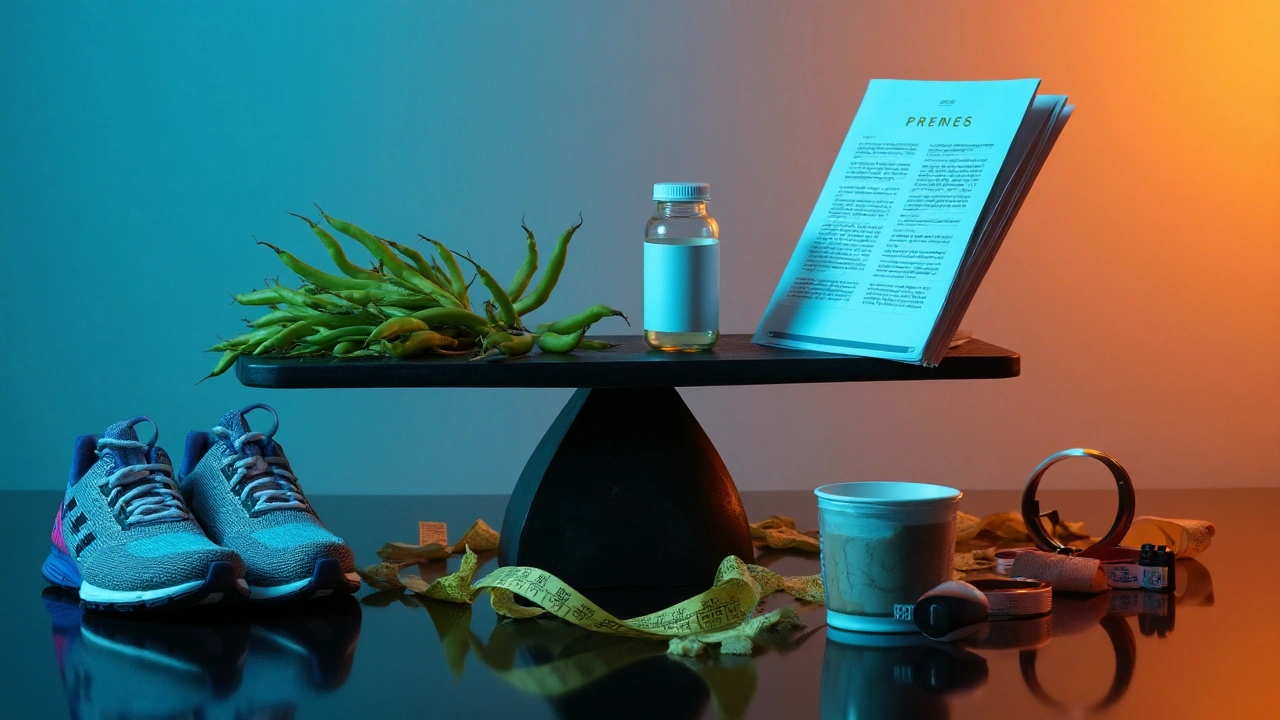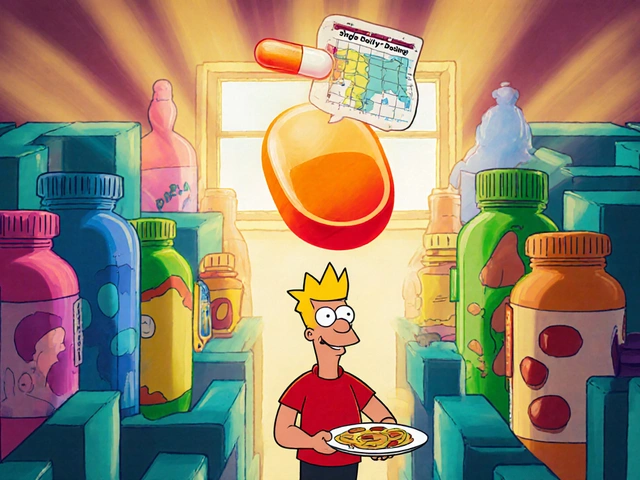You landed here because you’re looking for a real answer: do bean pod supplements actually help, or are they just clever marketing? Short answer: they can help with post-meal blood sugar and modest weight control, especially when refined carbs sneak into your diet. But they’re not magic. Think of them as a support act that works best alongside smart eating, movement, and sleep.
Expect an honest, practical guide: the science (what’s proven and what isn’t), how to choose a safe product in Australia, how to dose without wrecking your stomach, and how to weave it into a normal routine without obsessing over every gram of pasta.
- Bean pod products are usually from Phaseolus vulgaris pods; many store products are actually white kidney bean seed extracts that block some carb digestion.
- Strongest real-world use: blunting post-meal glucose spikes and supporting small, steady weight changes when eating high-carb meals.
- Evidence is mixed-to-modest. Government bodies say benefits exist but aren’t a cure; use them as a tool, not a fix.
- Safety is decent for most adults, but watch meds for diabetes, diuretics, and GI sensitivity; check the AUST L number on Australian labels.
- Best results come with consistent dosing before carb-heavy meals, plus protein, fiber, steps, and sleep.
What Bean Pod Supplements Are and What They Can (and Can’t) Do
“Bean pod” on a label usually points to Phaseolus vulgaris-the same species that gives us kidney, white, and green beans. Traditional European herbal medicine uses the pod (the shell) as a mild diuretic and for blood sugar support. Modern supplements on Aussie shelves, though, often lean on white kidney bean seed extract (phaseolamin), an alpha-amylase inhibitor. Translation: it can slow the breakdown of starch into sugar, so fewer carbs get absorbed from that meal.
Here’s the clean split:
- Pod-based products (often labeled “French bean pod” or “Phaseolus pod”): more traditional use, gentle diuretic effects, lighter data.
- Seed-based white kidney bean extract: the carb-blocker most people mean when they talk about bean supplements helping weight or blood sugar.
Why should you care about that difference? Because the pod and the seed don’t deliver the same active compounds or the same outcomes. The seed extract targets carb digestion. The pod sits more in the herbal/diuretic camp with softer metabolic effects.
What’s realistic?
- Blood sugar after carb-heavy meals: small-to-moderate blunting of post-meal spikes with white kidney bean extract. Several small randomized trials show reduced postprandial glucose and insulin curves when taken before starch-rich meals. Good for pizza nights, not a pass to eat recklessly.
- Weight management: modest support, mostly when higher-carb meals are a sticking point. Expect a nudge, not a transformation. Regulatory bodies like EFSA have rejected bold weight-loss claims in the past because of inconsistent evidence, even though some trials show small effects.
- Diuretic action (pod): traditional use for urinary flushing. Human evidence is limited; don’t expect dramatic fluid loss.
- Cholesterol and gut health: indirect wins via fiber-rich meals and slightly fewer digestible carbs. The supplement alone won’t move lipids much; your plate does the heavy lifting.
“Dietary supplements cannot replace the variety of foods that are important to a healthy diet.” - National Institutes of Health, Office of Dietary Supplements
Agencies worth knowing in 2025:
- Australia’s TGA: Listed medicines carry an AUST L number, showing they meet quality and permitted-ingredient rules. These products can only make low-level, evidence-backed claims.
- NIH Office of Dietary Supplements (US): Solid fact sheets on safety and efficacy.
- European regulators (EMA/EFSA): Tough on weight-loss claims; a good reality check when marketing gets loud.
| Product type | Main actives | Best-supported use | Evidence strength | Typical label dose | Notes |
|---|---|---|---|---|---|
| Phaseolus bean POD tea/extract | Polyphenols, minor saponins; gentle diuretic profile | Urinary flushing; light metabolic support | Traditional use with limited human trials | As per label; often 2-3 cups tea/day or 600-1,200 mg extract/day | Subtle effects; watch if on diuretics; not a glucose drug |
| White kidney bean SEED extract (carb blocker) | Phaseolamin (alpha-amylase inhibitor) | Blunting post-meal glucose; modest weight support | Mixed but reasonable for post-meal glucose; modest for weight | 500-1,000 mg 10-15 min before 1-2 starchy meals (up to ~3,000 mg/day) | Can cause gas/bloating; avoid if on strong glycemic meds without medical advice |
| Whole cooked beans (food) | Fiber, resistant starch, protein, minerals | Heart health, glycemic control, gut health | Strong epidemiology and clinical nutrition data | 1/2-1 cup cooked per meal | Best base strategy; low cost; synergizes with supplements |
Bottom line on the science: the seed extract has the clearest effect you can feel (especially if you’re carb-sensitive). The pod has a gentler, traditional footprint. Neither replaces a balanced plate, but they can give useful edges.

How to Choose, Dose, and Stack Bean Pod Supplements Safely
Here’s how to make this simple and safe, especially if you’re in Australia.
Quality checklist (Australia):
- Look for the AUST L number on the label. That means it’s a listed medicine on the Australian Register of Therapeutic Goods and made to GMP standards.
- Pick brands that declare the form: “pod extract” vs “white kidney bean extract (Phaseolus vulgaris seed).” The effect you want guides the form you buy.
- Avoid vague proprietary blends that hide how much phaseolamin or extract you’re getting.
- Consider third-party testing logos where available and a batch number with a use-by date.
- Short ingredient lists win. You don’t need ten herbs in one capsule to target carbs.
How to start (simple plan):
- Pick your target: carb spikes, gentle weight support, or urinary flushing.
- Match the product: seed extract for carb spikes/weight; pod tea/extract for gentler support.
- Start low for a week: half the label dose 10-15 minutes before your most carb-heavy meal.
- Track how you feel: energy after meals, fullness, bathroom habits, and any GI symptoms.
- Adjust: if tolerated, step up to the full dose; if gassy, drop back or pair with a bit more protein/fat.
Smart stacking (keeps it real-world):
- Timing beats quantity. Taking it 10-15 minutes before your starchy meal matters more than cranking the dose.
- Add protein at that meal (eggs, chicken, tofu) to slow glucose rise, and fiber (salad, legumes, veg) for satiety.
- Walk 10 minutes after dinner. Post-meal movement often lowers glucose more than any capsule.
- Hydrate. Especially with pod teas that have a mild diuretic effect.
- Sleep 7-8 hours. Poor sleep pushes hunger and insulin resistance, and no supplement outruns that.
Who should be cautious:
- If you take diabetes meds (metformin, sulfonylureas, insulin, SGLT2s, or GLP-1 shots), adding a carb blocker can drop post-meal glucose more than expected. Talk to your GP or pharmacist.
- If you’re on diuretics or have kidney concerns, go easy with pod teas and monitor.
- Allergy to legumes? Skip. Same if you’ve had severe GI issues with beans.
- Pregnant or breastfeeding? Data’s thin-play it safe and avoid unless your clinician says otherwise.
What dose actually works?
- White kidney bean seed extract: many labels recommend 500-1,000 mg shortly before your starchiest meals. Two meals per day is common. Most people cap at about 3,000 mg/day.
- Pod tea/extract: follow label dosing; these are gentler. Expect 2-3 cups of tea spread across the day or capsule equivalents.
Common side effects and fixes:
- Gas/bloating: start low, eat slower, and avoid stacking big servings of bread, pasta, and rice in one meal while you adapt.
- Cramping or urgent stools: back down the dose, time it earlier before the meal, or use with a smaller carb portion.
- Low energy after meals: could be a bigger-than-expected glucose drop; reduce dose or pair with more protein/fat.
Three quick heuristics that save money:
- Use it only when needed. If your meal is eggs, avocado, and greens, you don’t need a carb blocker.
- Cycle it. Heavy-carb days? Use. Lower-carb weekdays? Skip or go half-dose.
- Don’t expect weight loss from a capsule if your calorie balance is out of whack. Use it to soften carb swings, not to cancel dessert.
Costs in Australia (typical 30-day supply):
- Pod tea/extract: about AUD $15-$35 depending on brand and strength.
- White kidney bean extract: about AUD $20-$45 for listed products with clear dosing.

Real-World Use: Simple Plans, Checklists, and FAQs
The best plan is the one you’ll stick with. Here’s a straightforward template you can adopt tonight.
Example routine for a carb-sensitive person:
- Breakfast: eggs + spinach + one slice sourdough. No supplement needed.
- Lunch: sushi or a rice bowl. Take seed extract 10-15 minutes before eating.
- Dinner: pasta and salad. Take seed extract again, then walk for 10 minutes after.
- Hydration: if you’re using pod tea, spread 2-3 cups across morning and afternoon, not too close to bedtime.
Buying checklist (take this to the chemist or when shopping online):
- Does the label say “pod extract” or “white kidney bean extract (seed)”? Buy the right form for your goal.
- Is there an AUST L number? If yes, it’s on the ARTG; if no, rethink.
- Are doses transparent (e.g., 500 mg phaseolus seed extract per capsule)? Avoid blends that hide amounts.
- Short, clean excipients? Skip sugar-laden gummies and novelty blends.
- Return policy and batch number visible? Good sign.
7-day on-ramp plan:
- Days 1-2: Half-dose before your biggest starch meal; note energy, fullness, and GI comfort.
- Days 3-4: Full dose before that meal; add a 10-minute walk post-meal.
- Days 5-7: Full dose before your two starchiest meals; add a fist-sized serving of veg or salad to each.
What to track (keeps you honest):
- Post-meal energy 1-2 hours after eating (sluggish or steady?).
- Hunger in the afternoon and late night (less grazing?).
- Waist fit or scale change after 2-4 weeks (expect small shifts).
- Any GI symptoms and what meals triggered them.
Mini-FAQ
- Are bean pod supplements and white kidney bean extract the same? No. Pod products are the shell; white kidney bean extract is from the seed and acts as a carb blocker. Different actives, different outcomes.
- Can they replace diabetes medication? No. They can blunt post-meal spikes, but they are not a treatment. If you have diabetes or prediabetes, ask your doctor before adding them.
- Will they let me eat unlimited carbs? No. They reduce some starch breakdown; they don’t erase calories or protect against overeating.
- Do they work on sugar (like lollies) or only starches? Mostly starches (bread, pasta, rice, potatoes). Simple sugars aren’t affected the same way.
- What about GLP-1 meds (like semaglutide)? You may not need a carb blocker if you’re already eating less and absorbing slower. If you combine them, watch for nausea or low appetite and consider skipping the supplement.
- Is there caffeine? Not in bean pod or white kidney bean extracts. Don’t confuse them with green coffee bean products.
- How long until I notice anything? Often the first meal or two for GI sensations; 1-2 weeks for pattern-level changes like steadier energy or fewer cravings.
- Any nutrient issues? If you chronically block carbs and under-eat, you could shortchange energy. Aim for balanced meals.
Decision guide (quick):
- If your main struggle is big dinner carbs: use seed extract before dinner, walk after, keep protein decent.
- If you want a gentler herbal nudge and you hydrate well: try pod tea, morning and early afternoon.
- If your diet is already low in starch: you probably don’t need either; put money into protein, veg, and sleep.
Common pitfalls and fixes:
- “I felt bloated.” Fix: cut dose in half, add protein, chew more, and spread carbs across the day.
- “No weight change.” Fix: track total intake for a week. Use the supplement only for carb-heavy meals and trim liquid calories.
- “Energy dips.” Fix: pair with fat/protein, consider moving the capsule earlier, and avoid mega-carb feasts.
When to stop:
- If you get persistent cramps or diarrhea even on half-dose.
- If you’re seeing lower-than-expected blood sugars on medication.
- If you’re relying on it to justify nightly binges. Time for a different tactic.
What the evidence says in plain English:
- Trials on white kidney bean extract have documented reductions in post-meal glucose and modest weight changes in the short to medium term. Effects vary by dose, meal size, and individual response.
- Regulators demand consistent, large-scale evidence for big claims; that’s why you don’t see disease claims on AUST L products.
- Food-first patterns-beans, veg, lean proteins, and movement-deliver the bulk of benefits. The supplement helps most when temptation or routine gets in the way.
Fast start template (copy/paste for your week):
- Mon-Fri: Take seed extract before your two starchiest meals. Build 7,000-10,000 steps/day with a short walk after dinner.
- Sat: If you have a big social meal, dose once beforehand and add a salad or protein to the table.
- Sun: Pause and assess. Keep what worked; drop what didn’t.
A note on expectations: small wins compound. Three fewer energy crashes per week, two fewer late-night raids of the pantry, and a centimeter off the waist over a month-these add up. That’s the real “secret ingredient” effect: steady marginal gains, not headline-grabbing miracles.
Key reminders before you buy:
- Match the product to your goal, not the other way around.
- Check for the AUST L number in Australia and clear dosing.
- Use it with meals that justify it: bread, pasta, rice, noodles, potatoes.
- Pair with protein, fiber, and a short walk for outsized results.
And just to lock in one core idea: bean pod supplements work best as a supportive tool in a system you control-your plate, your steps, your sleep. Keep those steady, and the capsule actually has something to amplify.

 Celiac Disease in Children: Growth, Testing, and Diet Adherence
Celiac Disease in Children: Growth, Testing, and Diet Adherence
 Safe Topical Medications and Creams During Pregnancy: What You Can and Can’t Use
Safe Topical Medications and Creams During Pregnancy: What You Can and Can’t Use
 Bean Pod Supplements: Science-Backed Benefits for Better Health and Wellness (2025 Guide)
Bean Pod Supplements: Science-Backed Benefits for Better Health and Wellness (2025 Guide)
 Amaryl (Glimepiride) vs. Alternatives: Detailed Comparison for Type 2 Diabetes
Amaryl (Glimepiride) vs. Alternatives: Detailed Comparison for Type 2 Diabetes
 Liv.52 Drops vs. Top Liver Support Alternatives: Chicory & Caper Bush Compared
Liv.52 Drops vs. Top Liver Support Alternatives: Chicory & Caper Bush Compared
Keelan Walker
September 5, 2025 AT 20:08Hey folks 🌟 bean pod supplements can be a handy sidekick for those carb‑heavy meals and I love how they fit into a bigger wellness picture 🙌 they’re not a miracle cure but they do help smooth out that post‑lunch glucose rollercoaster especially if you’re prone to spikes 😅 the key is timing – pop the white kidney bean extract about 10‑15 minutes before you dive into pasta, rice or a big slice of pizza and you’ll notice a gentler rise in blood sugar 🍝📈 keep your dose consistent – most Aussie labels suggest 500‑1000 mg per carb‑dense meal and staying under the 3 g daily ceiling is usually safe ✅ watch out for gut reactions like a bit of gas or bloating – that’s a sign your body is adjusting to the carb‑blocking effect and you can dial the dose down a notch 💡 pairing the supplement with a good protein source or a fibre‑rich side can further blunt the spike – think chicken, beans or a salad 🥗 remember it works best alongside solid sleep, regular walks and balanced meals – no supplement can replace those basics 🛌🚶♂️ if you’re on diabetes meds (metformin, insulin, GLP‑1 agonists) have a chat with your GP because the combo can drop sugars lower than expected 🩺 and if you’re on diuretics or have kidney concerns keep an eye on the pod‑based teas – they’re milder but still have a diuretic vibe 💧 overall, think of bean pod products as a modest booster that rewards consistent, mindful eating habits 🎯 don’t expect a dramatic weight drop overnight – aim for steadier energy and fewer cravings over weeks 😊 stay curious, stay kind to your body, and you’ll see the subtle wins add up over time 🌱🚀
Heather Wilkinson
September 12, 2025 AT 18:48Great summary! 😊 I’d add that the pod tea can be a soothing ritual in the morning and also help with hydration – just sip it slowly and pair with a protein‑rich breakfast for best results 🌞💪
Henry Kim
September 19, 2025 AT 17:28I’ve tried the seed extract on a few busy weeks and noticed my energy steadied after lunch – no more afternoon slump that usually hits around 3 pm It seems the carbs get broken down slower so the insulin spike is milder 🚶♀️ I also keep a quick log of what I ate and how I felt which helps fine‑tune the dose over time 🗒️ If you’re new to this, start with half the suggested dose and watch for any GI changes before moving up 📊
Neha Bharti
September 26, 2025 AT 16:08Exactly – start low, track, adjust.
Samantha Patrick
October 3, 2025 AT 14:48Just a heads‑up – make sure the label shows a clear AUST L number and the exact milligram amount of phaseolamin. Some brands hide the dosage in a “proprietary blend” and that makes it hard to know what you’re actually getting 😬 Also, avoid gummies if you’re watching sugar – the capsule form is usually cleaner 👍
Ryan Wilson
October 10, 2025 AT 13:28Yeah, but honestly if you’re buying something that hides its ingredients you’re basically paying for a placebo – why waste money on mystery blends? Everyone talks about “natural” but that’s just marketing fluff. If you want real results, stick to products with transparent labs and third‑party testing, otherwise you’re just feeding the supplement industry’s profit machine. It's not a moral issue, it's science.
EDDY RODRIGUEZ
October 17, 2025 AT 12:08Alright team, let’s get pumped! 🎉 If you’re feeling sluggish after a carb‑laden dinner, grab that bean extract and hit it before you dig in – you’ll thank yourself when the evening slump doesn’t crash you 🤸♂️ Pair it with a short 10‑minute walk and watch the difference in how your body processes that starchy feast. Consistency is the secret sauce – doing this a few times a week can add up to noticeable energy gains and maybe a few extra inches off the waist over a month. Keep the vibe positive and remember: supplements are just the cherry on top of solid nutrition and activity 🍒💪
Christopher Pichler
October 24, 2025 AT 10:48While enthusiasm is great, let’s not ignore the bioavailability data – many of these extracts suffer from poor intestinal absorption unless formulated with a suitable carrier. Look for products that mention an optimized delivery system or a specific mg of phaseolamin, otherwise the theoretical carb‑blocking effect remains largely academic. Also, remember the terminology: “carb blocker” is a layman's term; the scientific community prefers “alpha‑amylase inhibitor.”
VARUN ELATTUVALAPPIL
October 31, 2025 AT 08:28Hey everyone!! I’m super curious about how these bean pod teas actually affect diuresis!! Are we talking mild water loss or something more significant??!! Also, any thoughts on the best time of day to drink them without disrupting sleep??!!
April Conley
November 7, 2025 AT 07:08Only sip after sunrise.
Sophie Rabey
November 14, 2025 AT 05:48Gotta say, the whole “block carbs” hype is kind of funny when you think about it – you still gotta eat the carbs, you just slow their breakdown. It’s like putting a speed bump on a highway; traffic still moves, just a tad slower. That said, for those with blood‑sugar spikes, even a modest reduction can feel like a win, especially if you pair it with a solid protein / fiber combo. Bottom line: not a magic bullet, but a useful tweak when used wisely.
Bruce Heintz
November 21, 2025 AT 04:28Exactly! 👍 The combo approach is key – carbs + protein + fiber = smoother glucose curve 😊
richard king
November 28, 2025 AT 03:08When one contemplates the metaphysical implications of a bean pod extract, one cannot help but marvel at the alchemy of nature‑derived alpha‑amylase inhibition – a dance of enzymes and phytochemicals that whispers of ancient culinary wisdom while flirting with modern biochemistry 🌿✨ Yet, let us not be seduced solely by poetic allure; the empirical data, though modest, tells a tale of incremental glycemic attenuation, a subtle yet measurable shift in postprandial trajectories. In the grand tapestry of nutraceuticals, this humble legume derivative occupies a niche that, while not revolutionary, may yet serve the diligent seeker of metabolic equilibrium.
Dalton Hackett
December 5, 2025 AT 01:48Nice poetic take! Just a quick note – the scientific literature does point out a high inter‑individual variability in response to Phaseolamin, likely due to differences in gut microbiota composition and baseline enzyme activity levels. So while the poetic view is appealing, the real takeaway is that you might need to trial the supplement and monitor your own glucose curves via a CGM or finger‑stick logs to see if you’re among the responders. Also, watch out for the “dose‑response plateau” – beyond ~2 g per day you’re unlikely to see added benefit but may increase GI side‑effects. Finally, keep an eye on the label’s manufacturing standards; a GMP‑certified facility reduces the risk of contaminants that could confound your results.
William Lawrence
December 12, 2025 AT 00:28Sure, but let’s not forget that the entire supplement market thrives on hype – many of these products are just capitalizing on the fear of carbs. If you’re not watching what you eat, a cheap capsule won’t fix anything. It’s like putting a band‑aid on a broken pipe – you’ll still have a leak.
Grace Shaw
December 18, 2025 AT 23:08While I respect the viewpoint expressed, I must emphasize that the regulatory frameworks governing listed medicines in Australia impose stringent quality controls and labeling requirements, thereby ensuring that any product bearing an AUST L designation adheres to a verified standard of safety and efficacy. Consequently, dismissing all such supplements as merely marketing ploys overlooks the nuanced evidence supporting modest glycemic benefits when employed as part of a comprehensive dietary strategy. It remains incumbent upon healthcare professionals to guide patients in integrating these agents responsibly, aligning usage with individualized health goals and existing pharmacotherapy.